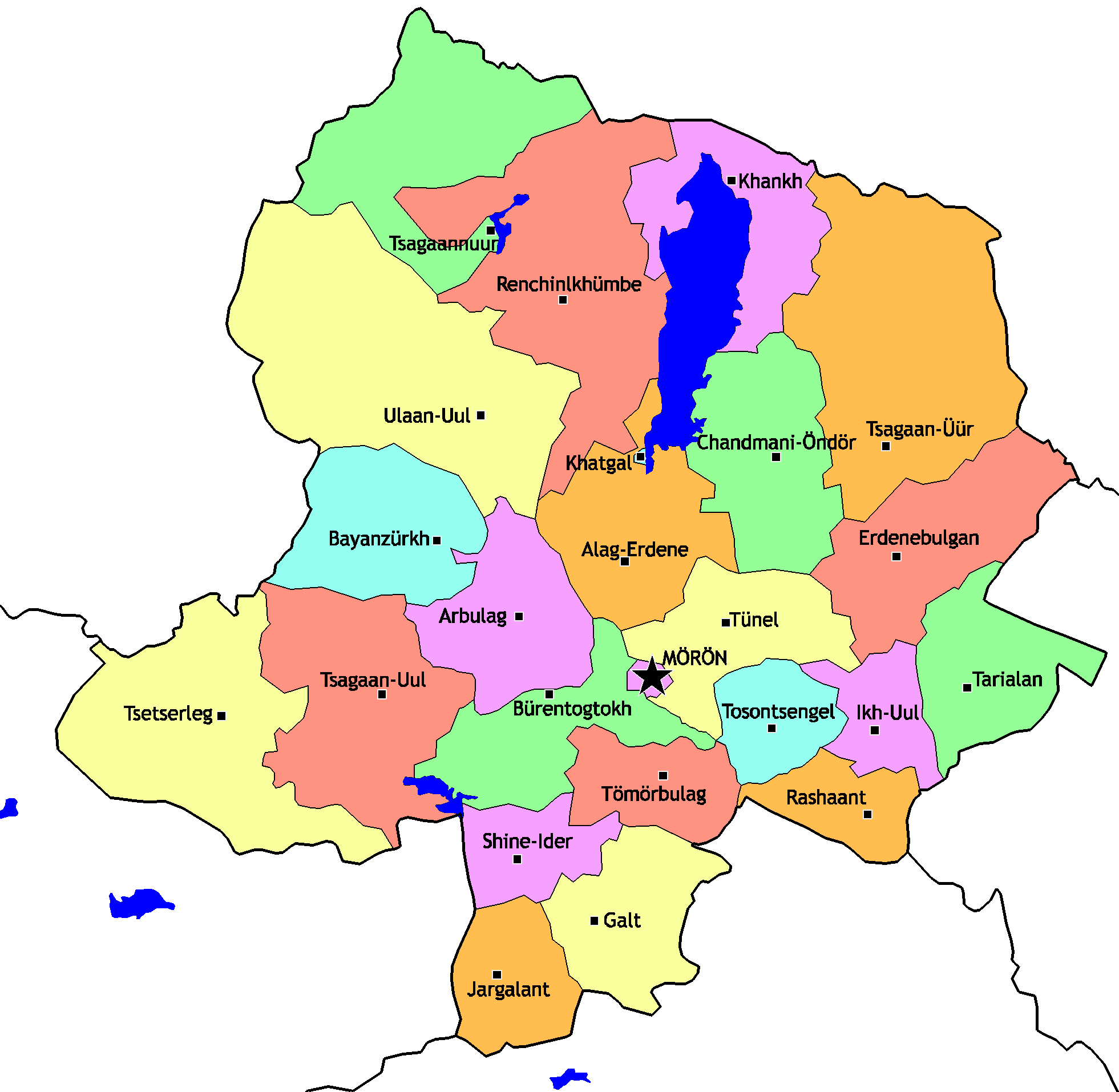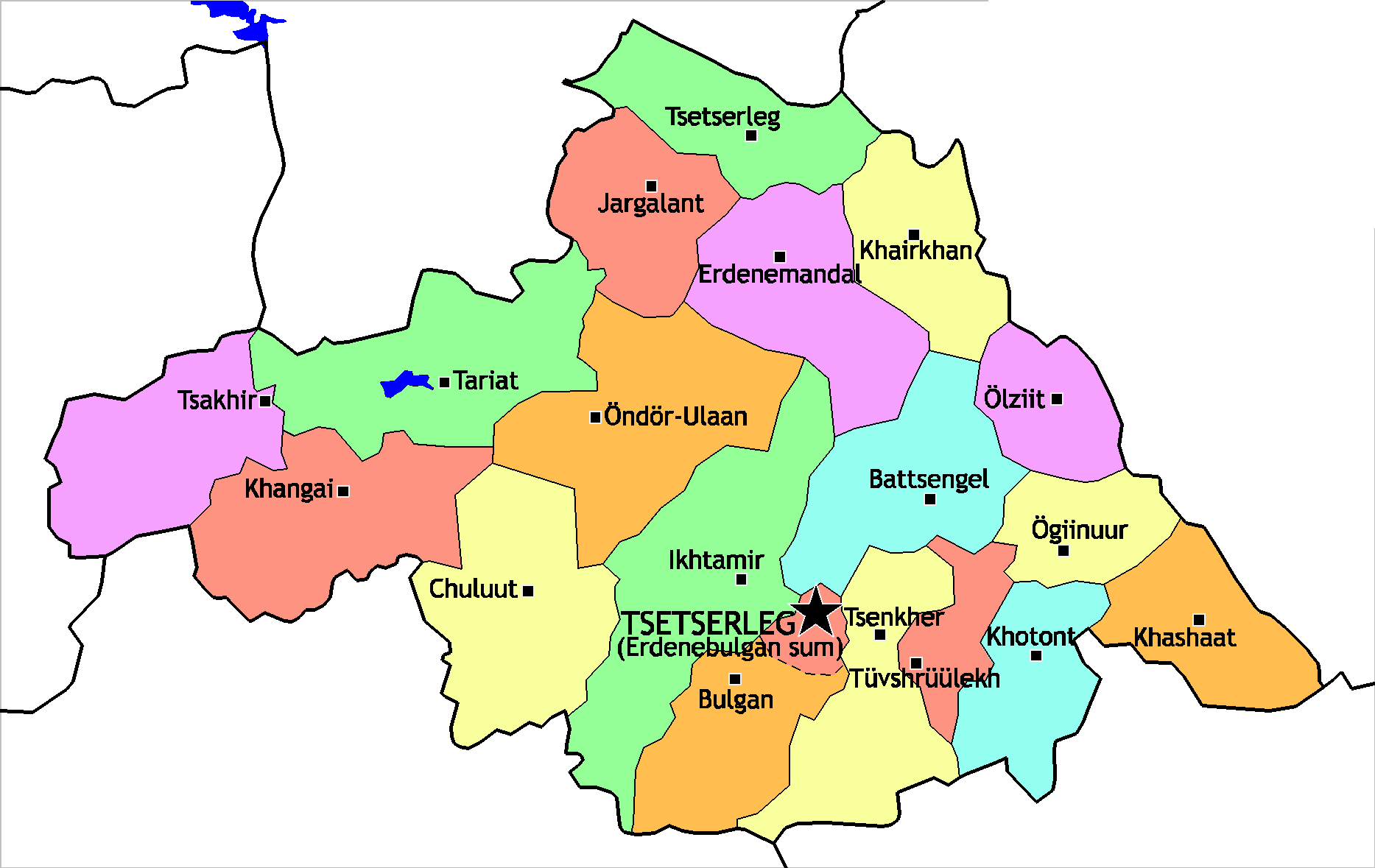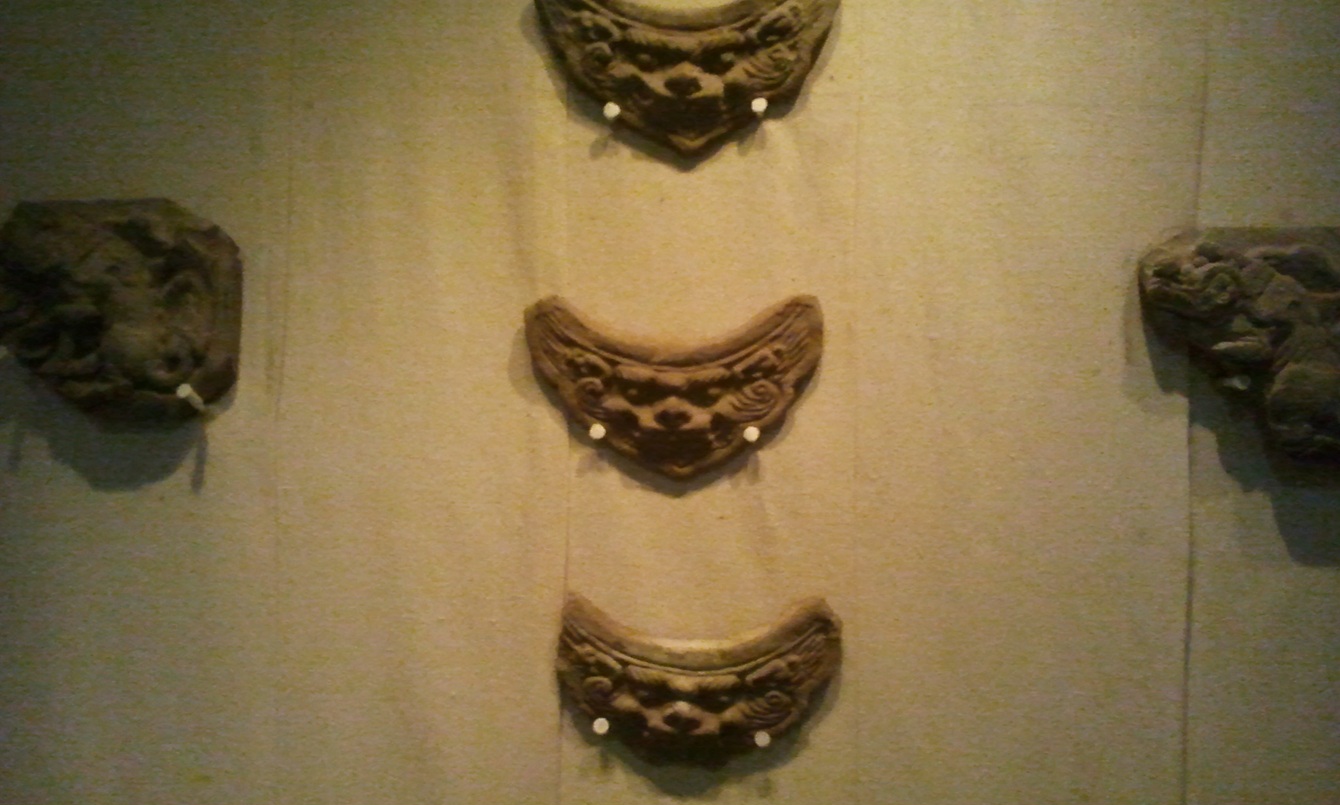|
Tosontsengel, Khövsgöl
Tosontsengel () is a sum of Khövsgöl Province, Mongolia. The area is 2,050 km2, of which 1,800 km2 are pasture and 11 km2 are farmland. In 2000, Tosontsengel had a population of 4,161 people, including some Khotgoid. The sum center, officially named ''Tsengel'' (), is located 64 km east-southeast of Mörön and 607 km from Ulaanbaatar. History The Tosontsengel sum was founded, together with the whole Khövsgöl aimag, in 1931. In 1933, it had 3,100 inhabitants in 842 households, and about 99,000 heads of livestock. In 1956, the local Ardyn Zorig (people's courage) negdel was founded. On 19 December 2001, a worldwide record high barometric pressure of 1,085.6 hectopascals (32.06 inHg) is recorded at Tosontsengel. Administrative divisions The district is divided into five bags, which are: * Mukhar Khundii * Selenge * Suul Ulaan * Teel * Tsengel Economy In 2004, there were about 137,000 heads of livestock, among them 64,000 goats, 57,000 sheep, 8,8 ... [...More Info...] [...Related Items...] OR: [Wikipedia] [Google] [Baidu] |
Districts Of Mongolia
A district or sum (; ) is a second-level administrative subdivision of Mongolia. The 21 provinces of Mongolia are divided into 330 Sum (administrative division), sums. On average, each district administers a territory of with about 5,000 inhabitants, primarily nomadic herders. Its total revenue is 120 million Mongolian tögrög, Tögrög, 90% of which comes from national subsidies. Each district is again subdivided into ''bags'' (brigades; sometimes spelled ''baghs''Montsame News Agency. ''Mongolia''. 2006, Foreign Service office of Montsame News Agency, , p. 46). Most bags are of an entirely virtual nature. Their purpose is to sort the families of nomads in the district into groups, without a permanent human settlement. Officially, and occasionally on maps, many district seats (''sum'' centers) bear a name different from that of the district. However, in practice the district seat (sum center) is most often referred to under the name of the district, to the point of the offic ... [...More Info...] [...Related Items...] OR: [Wikipedia] [Google] [Baidu] |
Countries Of The World
The following is a list providing an overview of sovereign states around the world with information on their status and recognition of their sovereignty. The 205 listed states can be divided into three categories based on membership within the United Nations System: 193 member states of the United Nations, UN member states, two United Nations General Assembly observers#Current non-member observers, UN General Assembly non-member observer states, and ten other states. The ''sovereignty dispute'' column indicates states having undisputed sovereignty (188 states, of which there are 187 UN member states and one UN General Assembly non-member observer state), states having disputed sovereignty (15 states, of which there are six UN member states, one UN General Assembly non-member observer state, and eight de facto states), and states having a political status of the Cook Islands and Niue, special political status (two states, both in associated state, free association with New ... [...More Info...] [...Related Items...] OR: [Wikipedia] [Google] [Baidu] |
Mongolia
Mongolia is a landlocked country in East Asia, bordered by Russia to the north and China to the south and southeast. It covers an area of , with a population of 3.5 million, making it the world's List of countries and dependencies by population density, most sparsely populated sovereign state. Mongolia is the world's largest landlocked country that does not border an Endorheic basin, inland sea, and much of its area is covered by grassy steppe, with mountains to the north and west and the Gobi Desert to the south. Ulaanbaatar, the capital and List of cities in Mongolia, largest city, is home to roughly half of the country's population. The territory of modern-day Mongolia has been ruled by various nomadic empires, including the Xiongnu, the Xianbei, the Rouran, the First Turkic Khaganate, the Second Turkic Khaganate, the Uyghur Khaganate and others. In 1206, Genghis Khan founded the Mongol Empire, which became the largest List of largest empires, contiguous land empire i ... [...More Info...] [...Related Items...] OR: [Wikipedia] [Google] [Baidu] |
Provinces Of Mongolia
__NOTOC__ Mongolia is divided into 21 provinces or aimags () and one provincial municipality. Each aimag is subdivided into several Districts of Mongolia, districts.Montsame News Agency. ''Mongolia''. 2006, Foreign Service office of Montsame News Agency, , p. 46 The modern provinces have been established since 1921. The capital, Ulaanbaatar, is governed as an independent provincial municipality separate from Töv Province, inside which it is situated. List of provinces See also *ISO 3166-2:MN, ISO 3166-2 codes for Mongolia *Lists of political and geographic subdivisions by total area *List of Mongolian provinces by GDP References External links Provinces of Mongolia at statoids.com {{Authority control Provinces of Mongolia, Subdivisions of Mongolia Lists of administrative divisions, Mongolia, Provinces Administrative divisions in Asia, Mongolia 1 First-level administrative divisions by country, Provinces, Mongolia Mongolia geography-related lists cs ... [...More Info...] [...Related Items...] OR: [Wikipedia] [Google] [Baidu] |
Khövsgöl Province
Khövsgöl () is the northernmost of the 21 Aimags of Mongolia, aimags (provinces) of Mongolia. The name is derived from Lake Khövsgöl. Geography and history The round-topped Tarvagatai (Khangai), Tarvagatai, Bulnain and Erchim sub-ranges of the Khangai Mountains, Khangai massif dominate the south and southwest of the largely mountainous province, and north and west of Lake Khövsgöl, lie the alpine Khoridol Saridag mountains, Khoridol Saridag, Ulaan Taiga, and Mönkh Saridag mountains. The center and eastern parts of the province are less mountainous, but still hilly. The region is well known in Mongolia for its natural environment, and Lake Khövsgöl is one of the country's major tourist attractions. The largest forests of Mongolia are located around and to the north of the lake, extending the South Siberian forest steppe, South Siberian taiga. The aimag was founded in 1931. Khatgal, Khövsgöl, Khatgal was the administrative center until 1933; since then it has been Mörö ... [...More Info...] [...Related Items...] OR: [Wikipedia] [Google] [Baidu] |
Sums Of Mongolia
A district or sum (; ) is a second-level administrative subdivision of Mongolia. The 21 provinces of Mongolia are divided into 330 sums. On average, each district administers a territory of with about 5,000 inhabitants, primarily nomadic herders. Its total revenue is 120 million Tögrög, 90% of which comes from national subsidies. Each district is again subdivided into ''bags'' (brigades; sometimes spelled ''baghs''Montsame News Agency. ''Mongolia''. 2006, Foreign Service office of Montsame News Agency, , p. 46). Most bags are of an entirely virtual nature. Their purpose is to sort the families of nomads in the district into groups, without a permanent human settlement. Officially, and occasionally on maps, many district seats (''sum'' centers) bear a name different from that of the district. However, in practice the district seat (sum center) is most often referred to under the name of the district, to the point of the official name of the district seat (sum center) being ... [...More Info...] [...Related Items...] OR: [Wikipedia] [Google] [Baidu] |
Khotgoid
Khotogoid or ( ) is a subgroup of the Mongols living in northwestern Mongolia. The Khotogoid people live roughly between Uvs Lake to the west and the Delgermörön river to the east. The Khotogoids belong to northwestern Khalkha and were one of the major groups that make up Khalkha. The best-known ruler of Khotogoids probably was Ubashi Huang Taizi, also known as Altan Khan of the Khotogoid (not to be confused with Altan Khan of Tumed) who was successful in subjecting Yenisei Kirghiz and pushing Oirats out of their domains in western Mongolia. The northern border of the Khotgoid Khanate reached modern Russian Krasnoyarsk city and the southern border reached the eastern Altay Mountains of Mongolia in the 17th century. The Khotogoid Khanate was not an independent state and its ruler was subject to Zasagtu khan aimag of Khalkha. In mid 17th century, because of the conflicts with neighboring Zasagtu Khan, the Khotogoids disintegrated and ceased to exist as a separate political ... [...More Info...] [...Related Items...] OR: [Wikipedia] [Google] [Baidu] |
Mörön (city)
Mörön (; ) is the administrative center of Khövsgöl Province, Khövsgöl, Mongolia. Before 1933, Khatgal, Khövsgöl, Khatgal had been the aimag capital. It has 12,286 families and a population of 46,918, and is considered a major city such as Ulaanbaatar, Darkhan (city), Darhan, Erdenet and Choibalsan (city), Choibalsan. In terms of administrative units, it is divided into 14 khoroo and covers approximately 102.9 km2. Demographics are split as 51.58% females to 48.42% males. 41.25% of the population is aged between 15 and 39. Although a poorly developed town, Mörön has a hospital, a museum, a theatre, a post office, nine schools and fifteen kindergartens. It was connected to the Mongolian central power grid in 2004. The town has had a paved road connecting it to Mongolia's capital city Ulaanbaatar since December 2014, as a part of a government effort to extend paved roads from Ulaanbaatar to all Aimag capitals. History The settlement stems from the Möröngiin Kh ... [...More Info...] [...Related Items...] OR: [Wikipedia] [Google] [Baidu] |
Ulaanbaatar
Ulaanbaatar is the Capital (political), capital and List of cities in Mongolia, most populous city of Mongolia. It has a population of 1.6 million, and it is the coldest capital city in the world by average yearly temperature. The municipality is located in north central Mongolia at an elevation of about in a valley on the Tuul River. The city was founded in 1639 as a nomadic Buddhist monasticism, Buddhist monastic centre, changing location 29 times, and was permanently settled at its modern location in 1778. During its early years, as Örgöö (anglicized as Urga), it became Mongolia under Qing rule, Mongolia's preeminent religious centre and seat of the Jebtsundamba Khutuktu, the spiritual head of the Gelug lineage of Tibetan Buddhism in Mongolia. Following the regulation of Kyakhta trade, Qing-Russian trade by the Treaty of Kyakhta (1727), Treaty of Kyakhta in 1727, a caravan route between Beijing and Kyakhta opened up, along which the city was eventually settled. With ... [...More Info...] [...Related Items...] OR: [Wikipedia] [Google] [Baidu] |
Negdel
Negdel (, "union, association") is the common term for the agricultural cooperatives in the Mongolian People's Republic. The full name is Khödöö aj akhuin negdel ( = ''Agricultural association''). History Early attempts The first attempts at agricultural collectivization in the Mongolian People's Republic were made in 1930-32, but failed miserably. Mongolia's livestock population decreased by around a third and the forceful manner in which collectivization was conducted lead to uprisings that could only be quelled with the help of the Soviet Union. Introduction of the negdel New attempts at collectivization were begun with different tactics and another name - the cooperatives in the early 1930s had been called khamtral, i.e. ''collective, kolkhoz'' - in the mid-1930s, but initially only on a very small scale: while there were 139 negdels country-wide in 1950,H.Barthel, ''Mongolei - Land zwischen Taiga und Wüste'', Gotha 1990, p. 108f in 1949 ten negdels in Khövsgöl ... [...More Info...] [...Related Items...] OR: [Wikipedia] [Google] [Baidu] |
Bags Of Mongolia
A bag ( ; ) or bagh is the smallest subdivision of Mongolia. It is a third-level subdivision and forms a constituent of a sum. Mongolia has a total of 1,664 bags. History During the Qing dynasty, some banners in Outer Mongolia had Bagh organizations, though these were not recorded in official historical records. According to archives, certain banners under the Khalkha Mongol tribes, such as the Chechen Khan, Güshi Khan, and Sain Noyan, had Bagh organizations. During the Bogd Khanate period (the period of Mongolian autonomy), Bagh was established as an administrative unit. After the establishment of the Mongolian People's Republic, it continued as a village-level administrative division. In Inner Mongolia, during the Qing dynasty, the Alashan Erut Banner and Maomingan Banner also had Bagh organizations. Etymology The word ''bag A bag, also known regionally as a sack, is a common tool in the form of a floppy container, typically made of cloth, leather, bamboo, paper ... [...More Info...] [...Related Items...] OR: [Wikipedia] [Google] [Baidu] |
Goat
The goat or domestic goat (''Capra hircus'') is a species of Caprinae, goat-antelope that is mostly kept as livestock. It was domesticated from the wild goat (''C. aegagrus'') of Southwest Asia and Eastern Europe. The goat is a member of the family Bovidae, meaning it is closely related to the sheep. It was one of the first animals to be domesticated, in Iran around 10,000 years ago. Goats have been used for milk, Goat meat, meat, Animal fur, wool, and Animal skin, skins across much of the world. Milk from goats is often turned into goat cheese, cheese. In 2022, there were more than 1.1 billion goats living in the world, of which 150 million were in India. Goats feature in mythology, folklore, and religion in many parts of the world, including in the classical myth of Amalthea (mythology), Amalthea, in Tanngrisnir and Tanngnjóstr, the goats that pulled the chariot of the Norse god Thor, in the Scandinavian Yule goat, and in Hinduism's goat-headed Daksha. In Christianity and ... [...More Info...] [...Related Items...] OR: [Wikipedia] [Google] [Baidu] |




